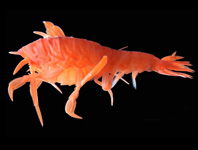Abstract
A female ovigerous specimen of the rare deep-living hyperiid Megalanceoloides remipes (Barnard, 1932) was collected with a remotely operated submersible (ROV) at a depth of 2,094 m in the Farallon Basin, Gulf of California. The specimen was found to be symbiotically associated with the siphonophore Apolemia sp. Eschscholtz, 1829. Hitherto, this species was known only from two other specimens, one from the South Atlantic and another from the Indian Ocean; the present record is the first from the Pacific Ocean. Previous descriptions lacked morphological details of different appendages; these data are provided here. In addition, we present the first data on its symbiotic association from in situ observations. The colors of the hyperiid and of some parts of the Apolemid were very similar, thus supporting the notion that some hyperiids tend to mimic the color of its host.
References
Barnard, K.H. (1932) Amphipoda. Discovery Reports, 5, 1–326.
http://dx.doi.org/10.5962/bhl.part.27664Gasca, R., Hoover, R. & Haddock, S.H.D. (2015) New symbiotic associations of hyperiid amphipods (Peracarida) with gelatinous zooplankton in deep waters off California. Journal of the Marine Biological Association of the United Kingdom, 95 (3), 503–511. [Published online, 24 October 2014.]
http://dx.doi.org/10.1017/S0025315414001416
Gasca, R., Suárez-Morales, E. & Haddock, S.H.D. (2007) Symbiotic associations between crustaceans and gelatinous zooplankton in deep and surface waters off California. Marine Biology, 151, 233–242. Published online, 27 September 2006.
http://dx.doi.org/10.1007/s00227-006-0478-y
Gilly,W.F., Beman, J.M., Litvin, S.Y. & Robison, B.H. (2013) Oceanographic and biological effects of shoaling of the oxygen minimum zone. Annual Reviews of Marine Science, 5, 393–420.
http://dx.doi.org/10.1146/annurev-marine-120710-100849
Harbison, G.R., Biggs, D.C. & Madin, P. (1977) The association of Amphipoda Hyperiidea with gelatinous zooplankton—II. Associations with Cnidaria, Ctenophora and Radiolaria. Deep Sea Research, 24, 465–488.
http://dx.doi.org/10.1016/0146-6291(77)90484-2
Lützen, J. (2005) Amphipoda (amphipods). In: Rohde, K. (Ed.), Marine Parasitology. CSIRO Publishing Melbourne and CABI Wallingford Oxon, pp. 165–169.
Madin, L.P. & Harbison, G.R. (1977) The associations of Amphipoda Hyperiidea with gelatinous zooplankton I. Associations with Salpidae. Deep Sea Research 24, 449–463.
http://dx.doi.org/10.1016/0146-6291(77)90483-0
Siebert, S., Pugh, P.R., Haddock, S.H.D. & Dunn, C.W. (2013) Re-evaluation of characters in Apolemiidae (Siphonophora), with description of two new species from Monterey Bay, California. Zootaxa, 3702 (3), 201–232.
http://dx.doi.org/10.11646/zootaxa.3702.3.1
Thuesen, E.V. & Haddock, S.H.D. (2013) Archeterokrohnia docrickettsae (Chaetognatha: Phragmophora: Heterokrohniidae), a new species of deep-sea arrow worm from the Gulf of California. Zootaxa, 3717 (3), 320–328.
http://dx.doi.org/10.11646/zootaxa.3717.3.2
Vinogradov, M.E. (1964) Hyperiidea Physosomata from the northern part of the Indian Ocean. Trudy Instituta Okeanologii Akademiya Nauk SSSR, 65, 107–151. [In Russian]
Zeidler, W. (2009) A review of the hyperiidean amphipod superfamily Lanceoloidea Bowman & Gruner, 1973 (Crustacea: Amphipoda: Hyperiidea). Zootaxa, 2000,1–117.

